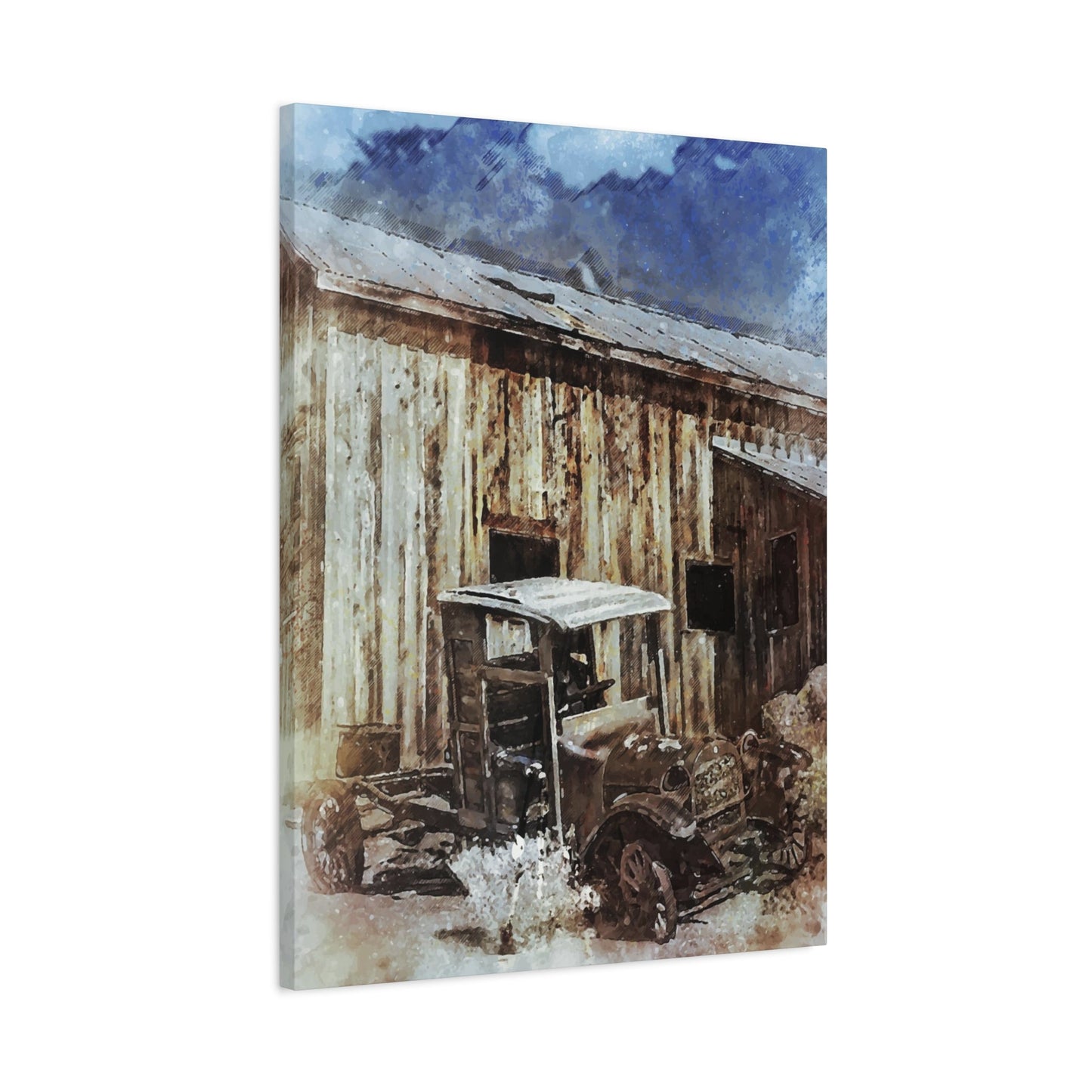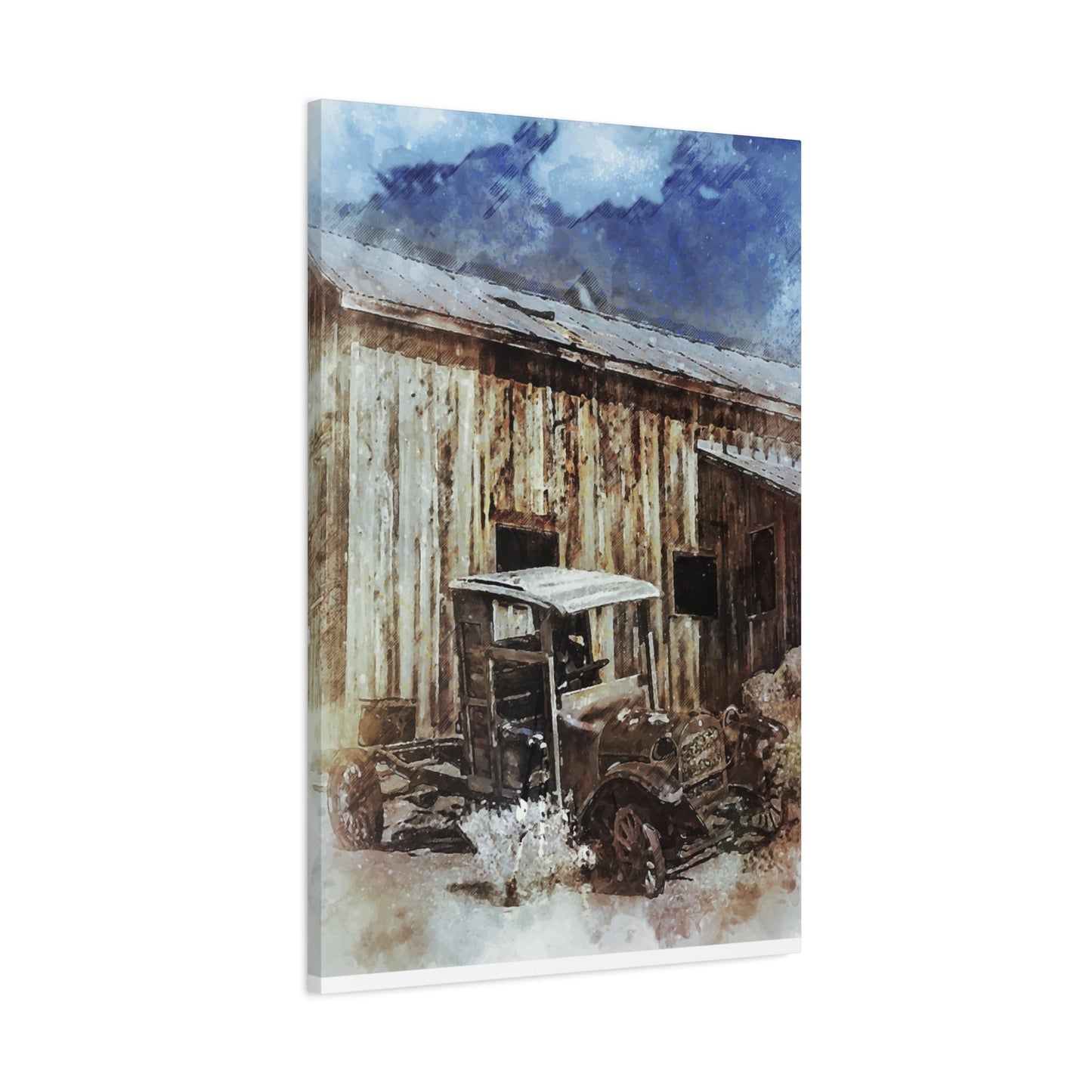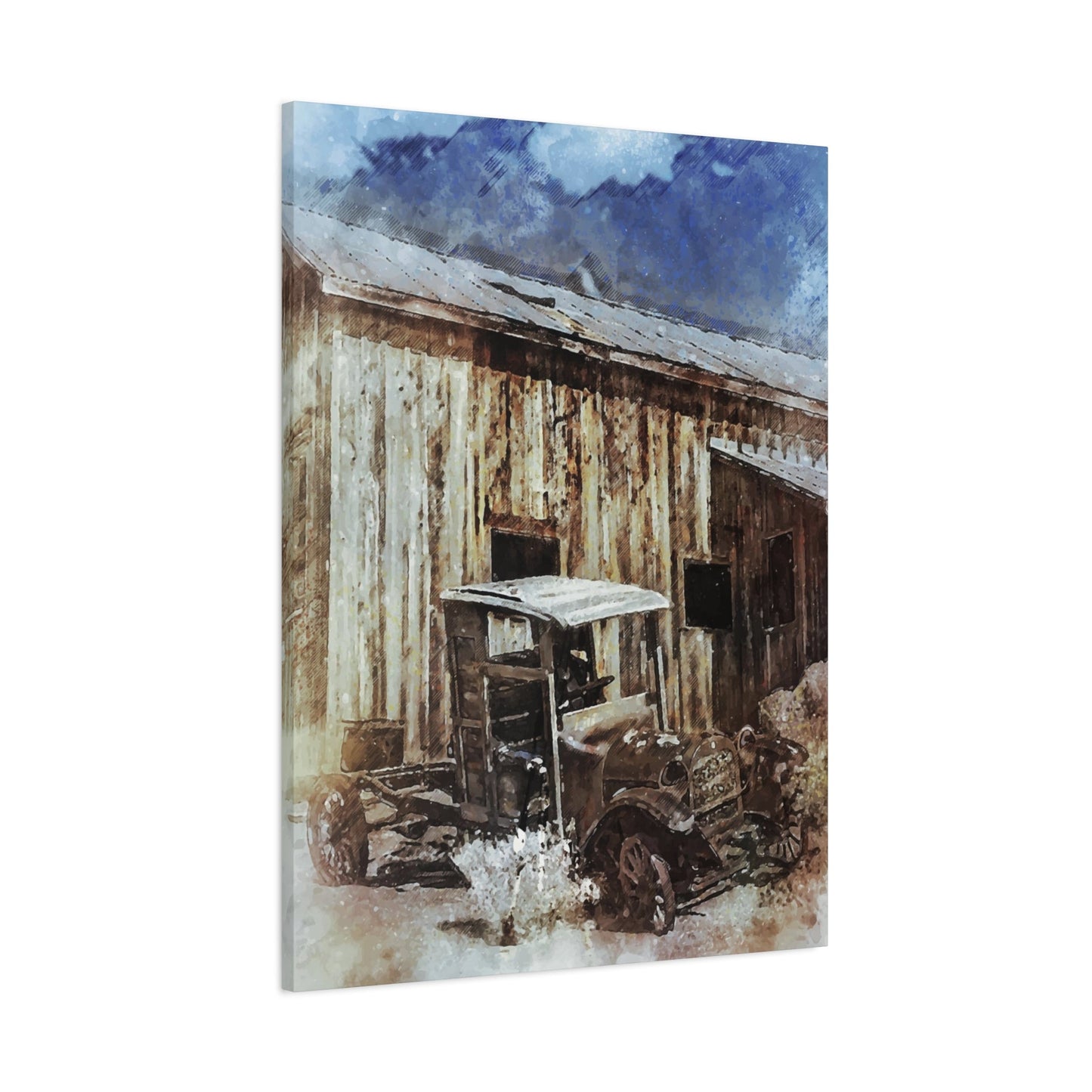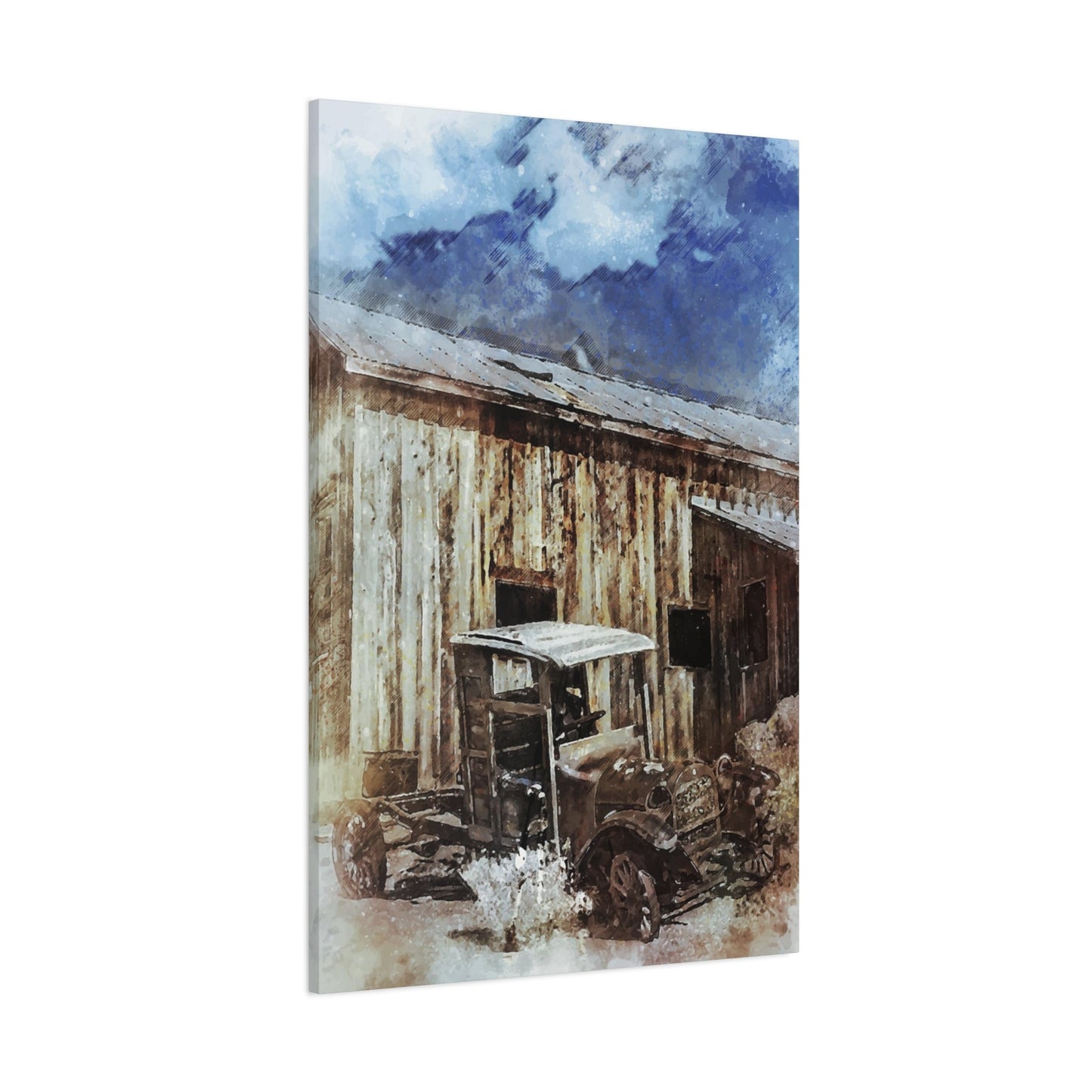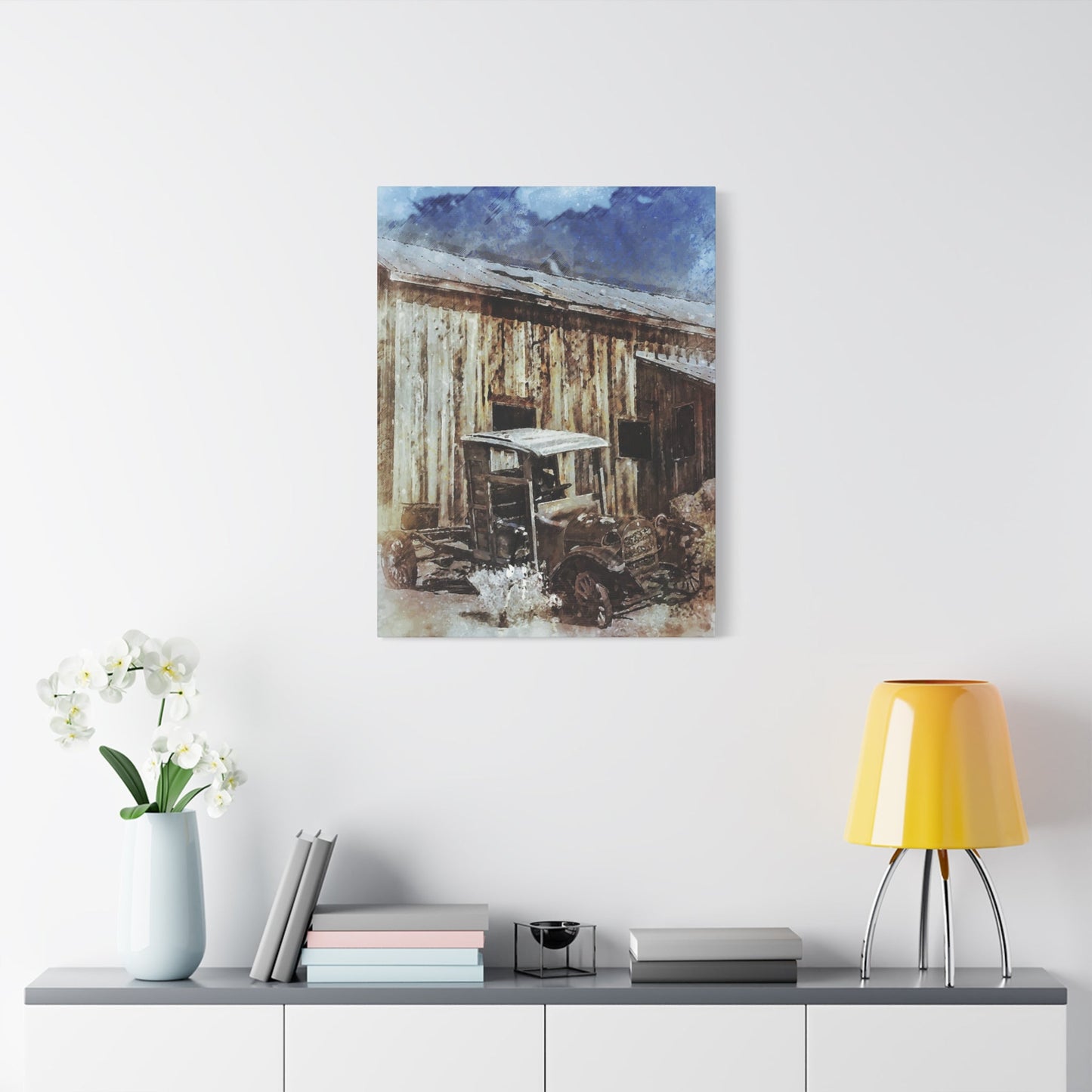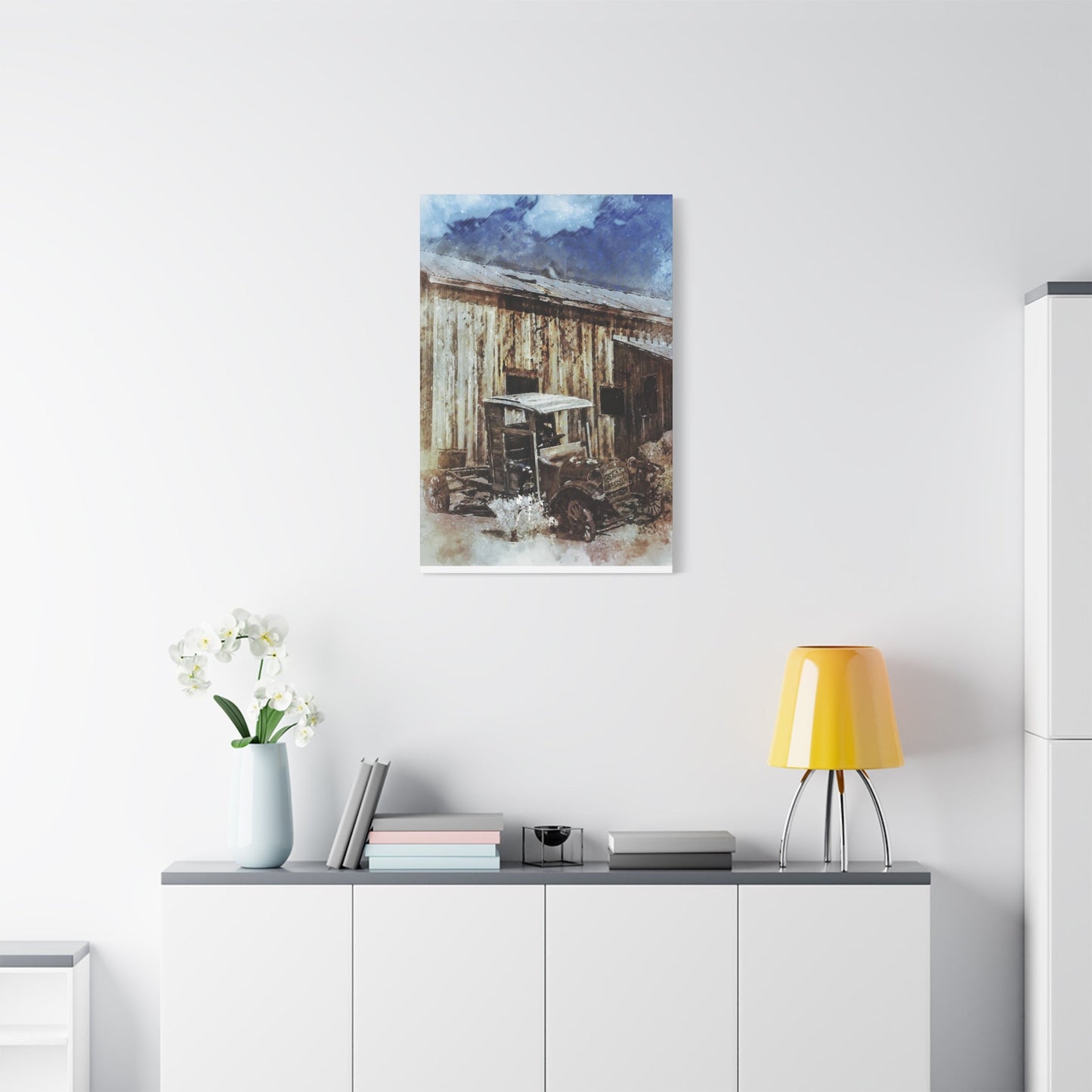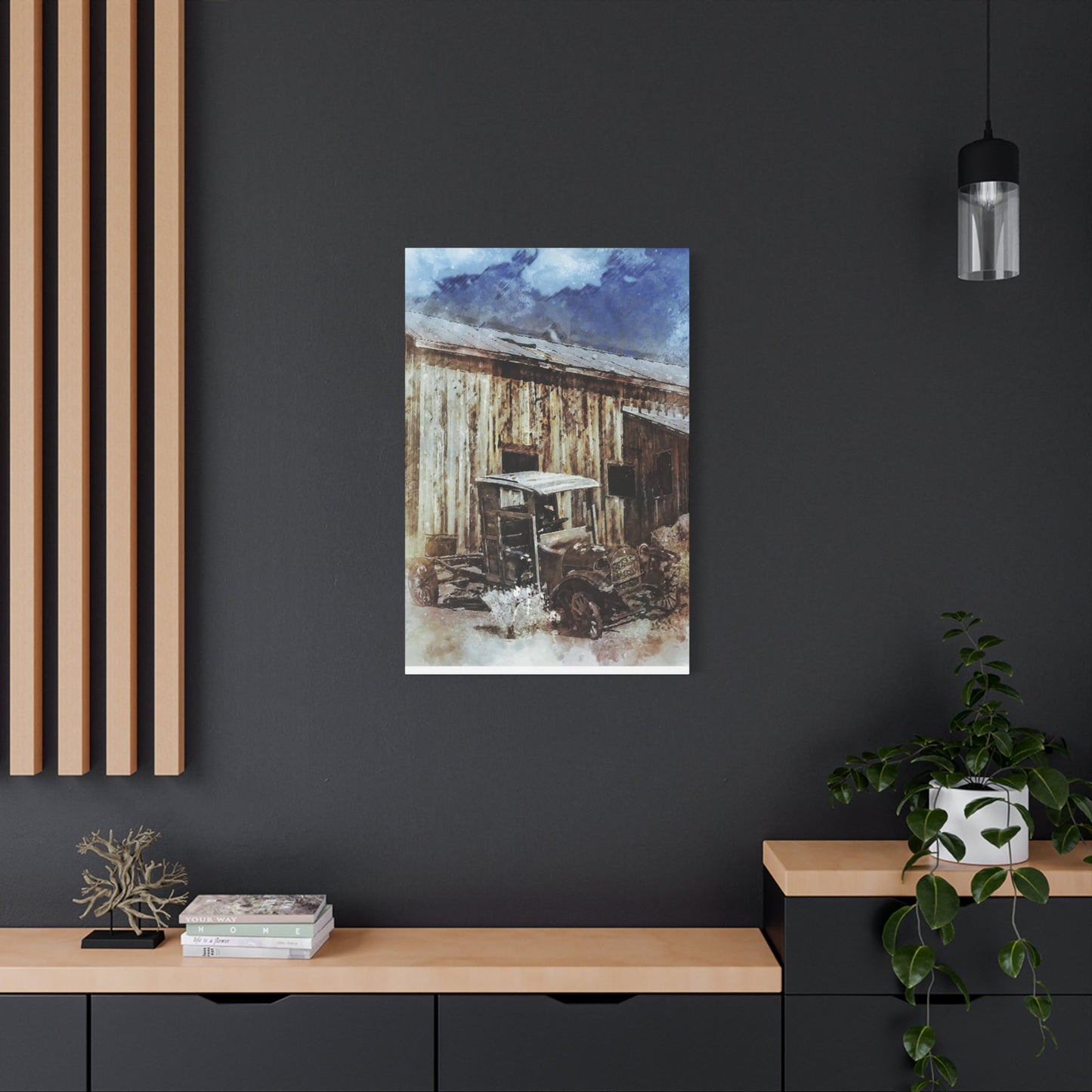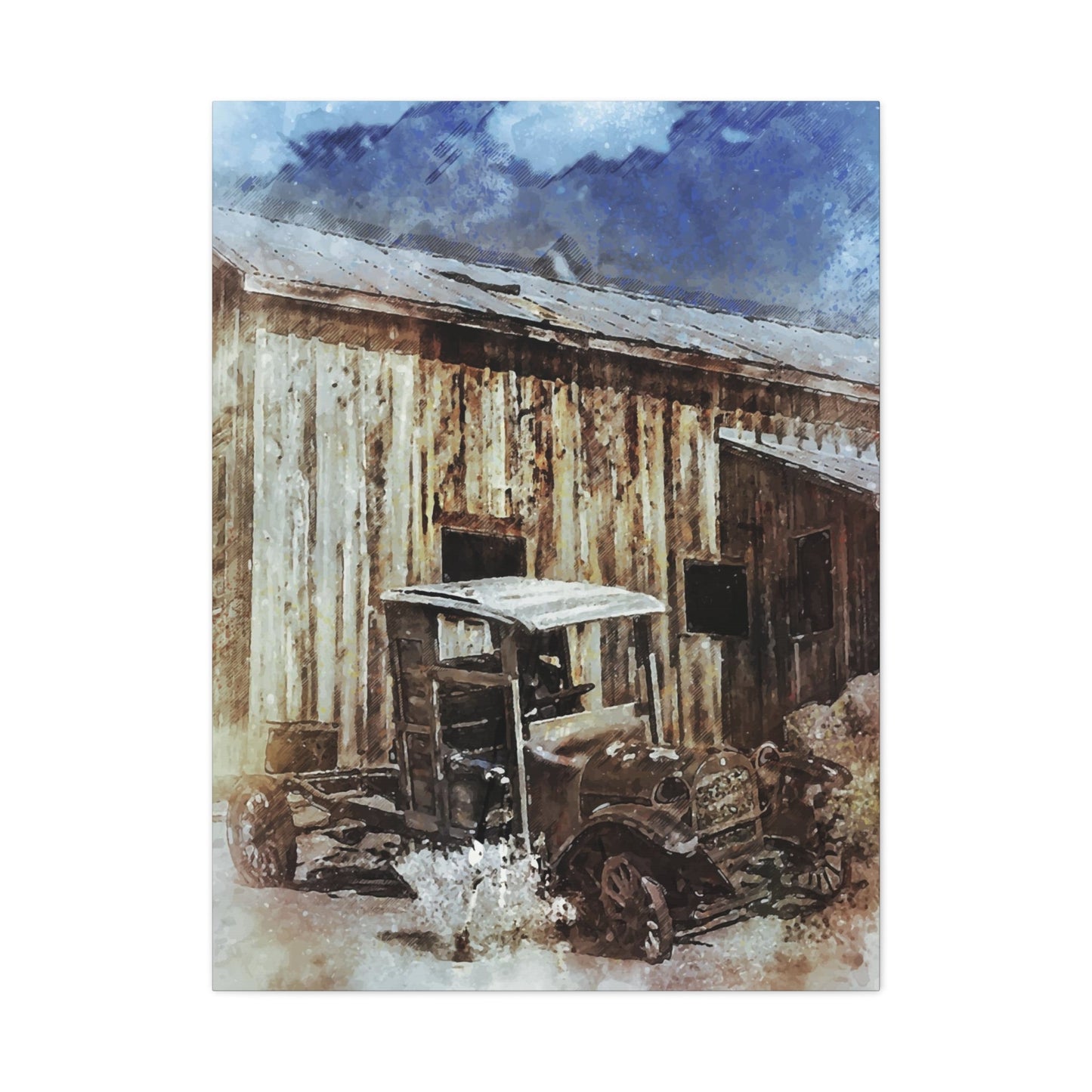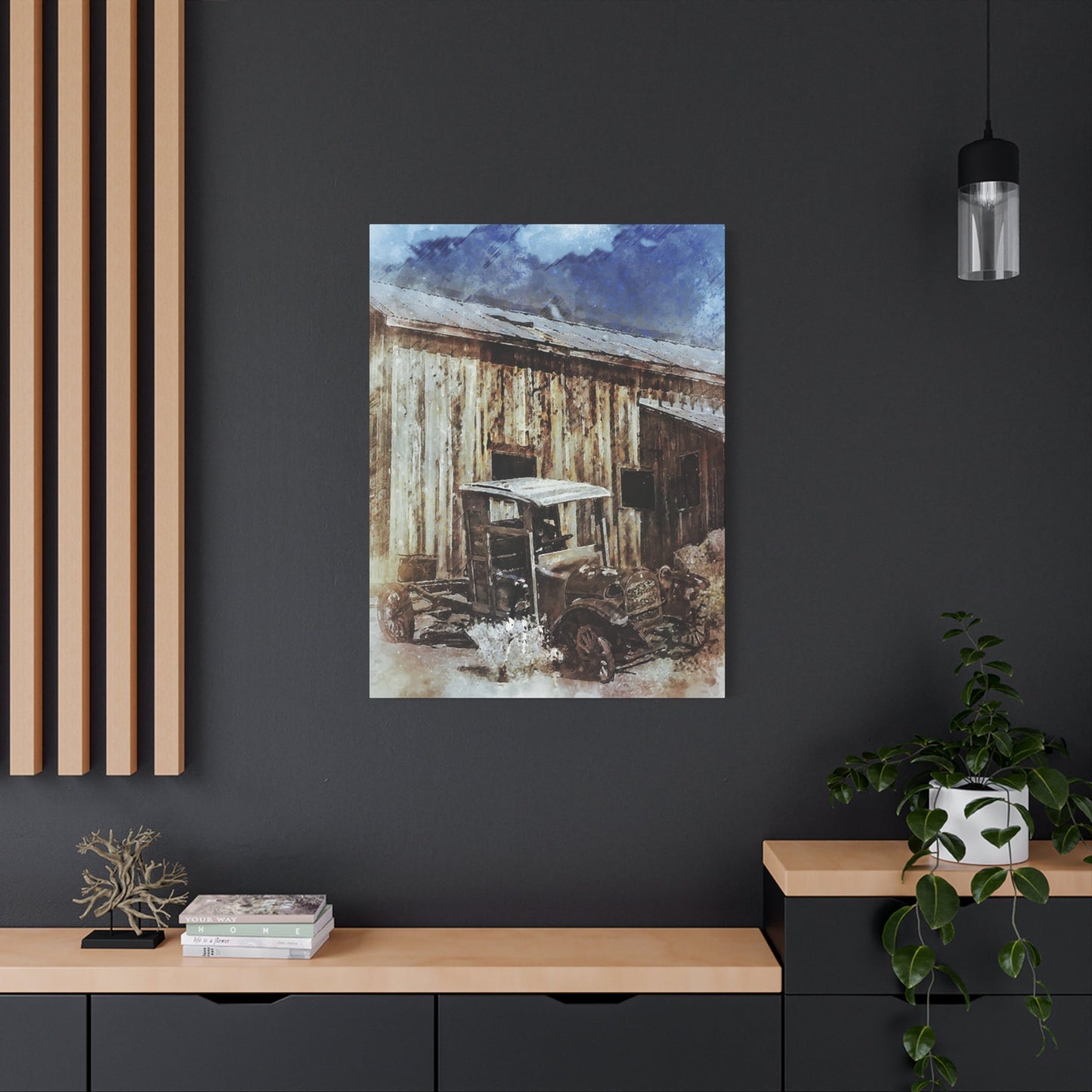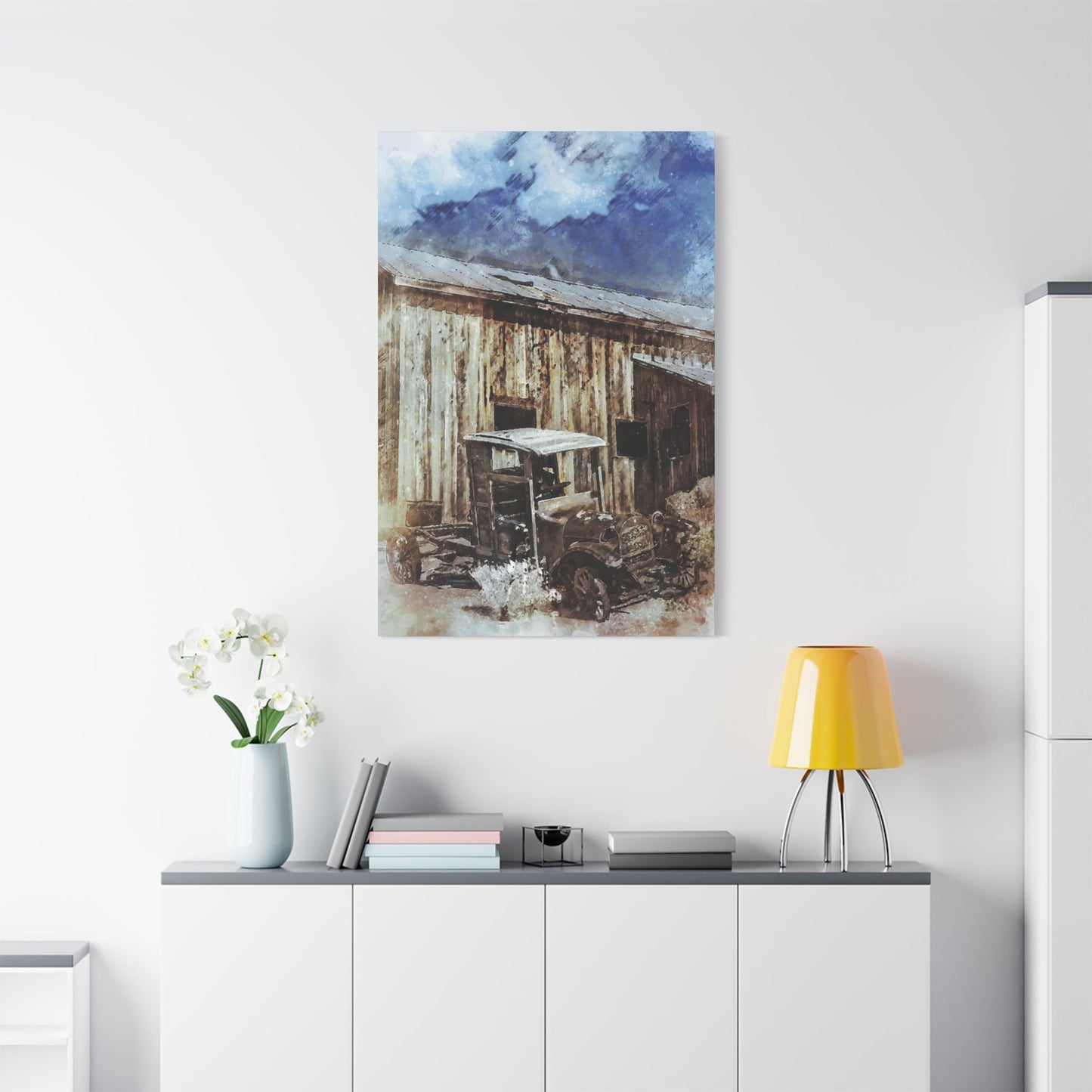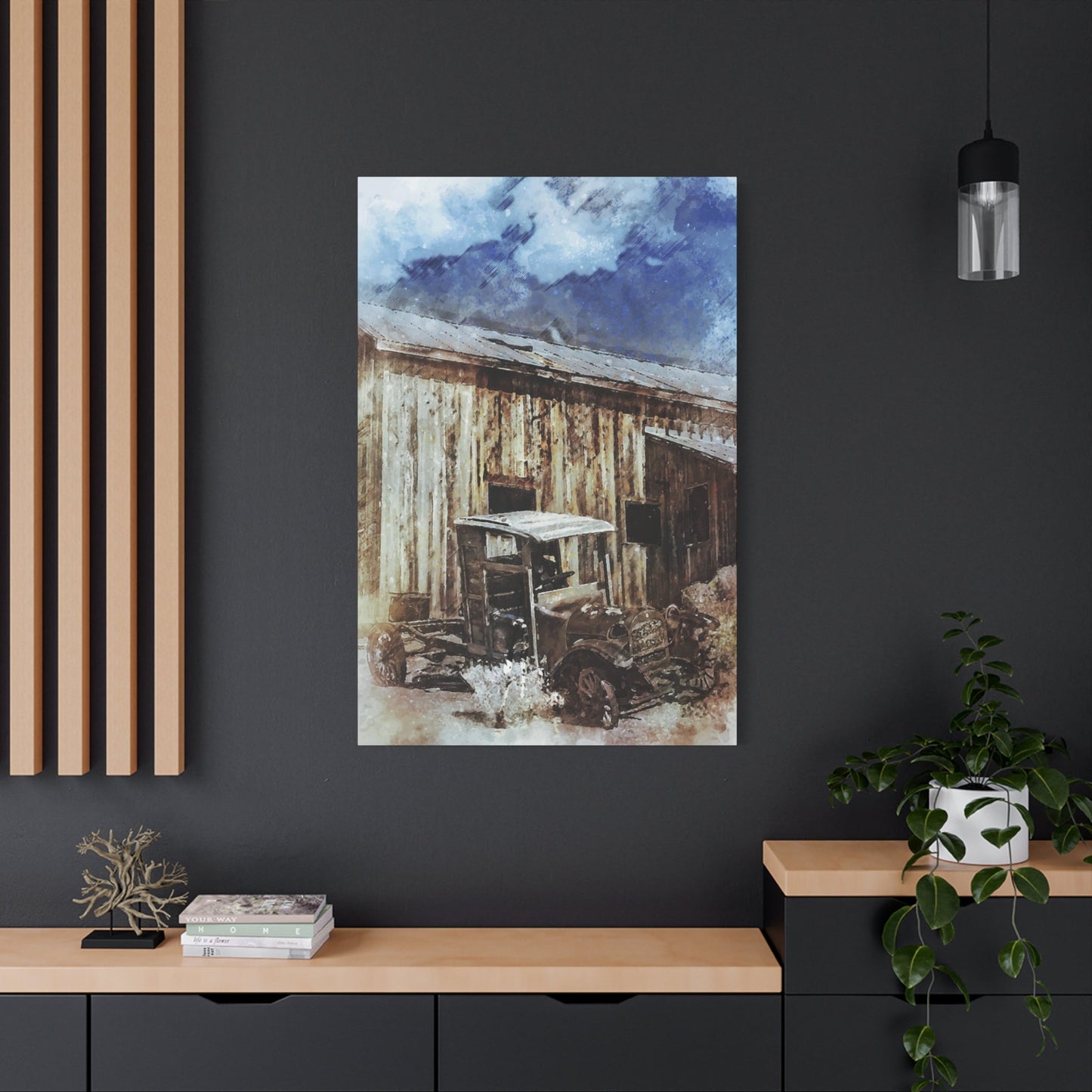An Expert Guide to Vintage Car Wall Art: Styles, Themes, and Creative Decorating Ideas
The allure of classic automobiles transcends mere transportation; it represents an era of unparalleled craftsmanship, iconic design, and a powerful sense of nostalgia. Capturing this essence within our living and working spaces has become a sophisticated form of personal expression. Vintage car wall art and canvas prints offer a unique portal to the past, allowing us to celebrate the golden age of automotive history. This art form is not just about hanging a picture of an old car; it is about curating an atmosphere, telling a story, and appreciating the fusion of engineering and artistry that defined generations of vehicles.
From the sweeping fins of a 1950s Cadillac to the muscular stance of a 1960s muscle car, each piece of artwork serves as a tribute to innovation and style. The appeal lies in the intricate details—the gleam of polished chrome, the reflection in a curved windshield, the specific shade of paint that evokes a particular year and model. This comprehensive exploration delves deep into the world of vintage car wall art, examining its cultural significance, its impact on interior design, and the vast array of styles and mediums available to enthusiasts and collectors. It is a journey into how these static images can evoke a dynamic sense of freedom, adventure, and timeless elegance, transforming any room into a gallery of automotive legends.
The Enduring Appeal of Classic Automobile Artwork
The fascination with classic automobile artwork stems from a deep-seated human connection to history, aesthetics, and storytelling. These vehicles are more than just machines; they are cultural artifacts that embody the spirit of their time. A canvas print featuring a 1957 Chevrolet Bel Air, for instance, doesn't just depict a car; it channels the optimism and rock-and-roll energy of post-war America. The artwork acts as a powerful nostalgic trigger, transporting viewers back to a cherished memory or a romanticized era they wish they had experienced. This emotional resonance is a key driver of its enduring appeal. Furthermore, the design principles of vintage cars make them exceptional artistic subjects. Automotive designers of the past were often unencumbered by modern regulations and aerodynamic homogenization, allowing them to create rolling sculptures.
The dramatic curves, bold grilles, and ornate details provide endless inspiration for artists. Photographers and painters are drawn to the interplay of light and shadow on these complex surfaces, the way a sunset reflects off a polished hood, or the intricate design of a wire-spoke wheel. Vintage car wall art celebrates this masterful design, isolating the vehicle from its functional context and presenting it as a pure object of beauty. It allows us to appreciate the lines, form, and color choices that made these cars iconic. This appreciation for historical design and emotional connection ensures that classic automobile artwork remains a timeless and compelling choice for decorators and art lovers alike, offering a piece of history that is both visually stunning and rich with meaning.
Selecting Canvases That Celebrate Automotive History
Choosing the right canvas print to celebrate automotive history is a deeply personal process that involves balancing aesthetic preferences with the story one wishes to tell. The selection goes far beyond simply picking a favorite model. It is about considering the context, the artistic style, and the emotional impact the piece will have on a space. One of the first considerations should be the era of the vehicle depicted. Are you drawn to the pre-war elegance of a Rolls-Royce or a Duesenberg, with their regal presence and intricate coachwork? Or perhaps the post-war boom, represented by the optimistic and chrome-laden designs of American cars from the 1950s, is more your style. The raw power and rebellious spirit of 1960s and 70s muscle cars offer another distinct aesthetic, perfect for spaces that aim for a more energetic and dynamic feel.
The artistic interpretation of the vehicle is equally important. A hyper-realistic painting or a high-definition photograph will emphasize the car's engineering and design perfection, highlighting every nut, bolt, and reflection. Conversely, an impressionistic or abstract piece might focus on the feeling of speed, the play of color, or the overall form, creating a more interpretive and artistic statement. The medium of vintage car canvas prints itself adds a layer of texture and depth that flat posters cannot replicate, giving the artwork a more substantial and gallery-worthy presence. When selecting a piece, consider the existing decor of your room. An industrial loft might be the perfect backdrop for a gritty, black-and-white print of a race car in a workshop, while a modern minimalist space could be enhanced by a bold, colorful pop-art rendition of a classic convertible. Ultimately, the perfect canvas is one that not only showcases a beautiful machine but also resonates with your personal history and passion for the golden age of motoring.
The Intersection of Interior Design and Retro Car Decor
The integration of retro car decor into interior design schemes is a testament to the genre's versatility and broad appeal. Far from being confined to garages or "man caves," vintage car wall art can elevate a wide range of interior styles, from rustic to contemporary. The key to a successful integration lies in understanding how the artwork's elements—color, form, and subject matter—interact with the surrounding space. In a modern or minimalist setting, a single, large-scale canvas print of an iconic car can serve as a powerful focal point. Imagine a sleek, white-walled living room punctuated by a vibrant, detailed image of a red Ferrari 250 GTO. The artwork introduces a splash of color and a dynamic sense of history without overwhelming the room's clean lines. For industrial-style interiors, which often feature exposed brick, metal, and wood, vintage car wall art feels right at home.
Pieces that depict cars in motion, workshop scenes, or gritty, black-and-white photographs of racing legends complement the raw, functional aesthetic of the space. In more traditional or rustic settings, such as a study with wood paneling or a country home, artwork featuring classic woodie wagons, pastoral scenes with vintage trucks, or elegant pre-war automobiles can add a touch of warmth and nostalgia. The color palette of the artwork should also be considered. A piece with muted, earthy tones can blend seamlessly with a neutral-colored room, while a print with bold, primary colors can be used to create a deliberate and exciting contrast. The framing or mounting of the canvas also plays a role. A gallery-wrapped canvas offers a clean, contemporary look, while a rustic wood frame can enhance a more traditional or farmhouse-style decor. By carefully considering these elements, retro car decor transcends mere hobbyist interest and becomes a sophisticated design tool, capable of adding personality, history, and a unique artistic flair to any home.
The Art of Capturing Automotive Legends on Canvas
Translating the three-dimensional power and beauty of an automotive legend onto a two-dimensional canvas is a true art form, requiring a unique blend of technical skill and creative vision. Artists who specialize in vintage car wall art are not merely illustrators; they are storytellers and historians who understand the soul of the machine. The process begins with an intimate understanding of the subject. This involves studying the car's design language, its historical context, and the subtle nuances that make it iconic. For a photographer, this might mean waiting for the perfect light—the "golden hour" at dawn or dusk—to capture the way sunlight accentuates the vehicle's curves and reflects off its polished surfaces. The choice of angle is crucial; a low-angle shot can make a car appear more dominant and powerful, while a side profile can emphasize its length and elegant lines. For a painter, the process is even more interpretive.
They must decide which details to emphasize and which to soften. A hyper-realist painter might spend hundreds of hours meticulously recreating every reflection, texture, and emblem, aiming for a level of detail that rivals a photograph. An impressionist, on the other hand, might use bold brushstrokes and a vibrant palette to convey the feeling of speed and excitement, focusing on the essence of the car rather than a literal depiction. The medium itself—be it oil, acrylic, watercolor, or digital paint—profoundly influences the final piece. Oils allow for rich, deep colors and smooth blending, ideal for capturing the glossy finish of a classic car's paint job. Acrylics offer vibrant colors and fast drying times, lending themselves to more graphic and pop-art styles. Ultimately, the most successful vintage car canvas prints are those that do more than just replicate a car's appearance.
Infusing Spaces with the Spirit of a Bygone Motoring Era
Infusing a space with the spirit of a bygone motoring era is about more than just decoration; it is about creating an immersive atmosphere that evokes a specific time and feeling. Vintage car wall art is the primary catalyst for this transformation, acting as a window into the past. The key is to curate a collection that tells a cohesive story. For instance, to evoke the glamour and sophistication of the Art Deco period, one might select prints of streamlined, elegant vehicles from the 1930s, like the Bugatti Type 57 Atlantic or the Cord 810. These pieces, characterized by their long hoods and flowing fenders, can be paired with geometric patterns, metallic accents, and luxurious materials in the room's decor to create a truly immersive experience.
To capture the rebellious, free-spirited vibe of the 1960s, a gallery wall featuring a mix of American muscle cars, British roadsters, and iconic counter-culture vehicles like the Volkswagen Beetle would be highly effective. These vintage car canvas prints could be complemented by mid-century modern furniture, shag carpets, and a color palette of avocado green and burnt orange. The artwork sets the tone, and the surrounding decor elements reinforce it. The placement of the art is also critical. A large, dramatic canvas of a car speeding down an open road, placed prominently in an entryway or living room, immediately establishes a theme of freedom and adventure. A series of smaller, more detailed prints showing close-ups of badges, grilles, or interiors can create a more intimate and studious atmosphere in an office or library. By thoughtfully selecting and arranging vintage car wall art, you can do more than just adorn your walls.
Decoding the Symbolism in Classic Car Imagery
Classic car imagery is laden with symbolism, with each vehicle carrying a rich tapestry of cultural, social, and personal meanings that extend far beyond its mechanical function. When we display vintage car wall art, we are often subconsciously tapping into this deep well of symbolism. A Ford Mustang, for example, is not just a car; it is a potent symbol of American freedom, youth, and rebellion. A canvas print of a first-generation Mustang instantly evokes feelings of open roads, popular music of the 1960s, and a sense of untamed adventure. Similarly, the Volkswagen Beetle represents more than just economical transportation. It is a symbol of the counter-culture movement, peace, and a simpler, more unconventional way of life. Its friendly, unassuming design became an icon of anti-establishment sentiment. On the other end of the spectrum, luxury marques like Rolls-Royce or Cadillac symbolize aspiration, success, and status.
A piece of art featuring a gleaming Cadillac Eldorado with its iconic tailfins speaks to an era of American prosperity, confidence, and technological optimism. European sports cars, like the Jaguar E-Type or the Porsche 911, carry their own unique symbolism. They often represent sophistication, precision engineering, and a passion for driving as a pure, exhilarating experience rather than a mere commute. The E-Type, famously described as the most beautiful car ever made, symbolizes timeless elegance and British sporting heritage. Even the color of the car in the artwork can be symbolic. A red sports car often signifies passion, speed, and danger, while a black luxury sedan might convey power, elegance, and mystery. By understanding these layers of meaning, the selection of vintage car canvas prints becomes a more deliberate and meaningful act. It allows us to choose a piece that not only looks beautiful but also communicates a specific message or resonates with our own values and aspirations.
Curating a Gallery of Automotive Masterpieces
Creating a gallery wall of automotive masterpieces is a sophisticated way to showcase a passion for vintage cars and transform a plain wall into a dynamic and engaging focal point. A successful gallery wall is more than just a random assortment of pictures; it is a curated collection that follows a theme, a color scheme, or a narrative. One effective approach is to focus on a specific theme. This could be a particular decade, such as a collection of iconic cars from the 1950s, allowing for a cohesive display of chrome, pastels, and tailfins. Another theme could be a specific country of origin, creating a wall dedicated to the finest examples of Italian design, German engineering, or American muscle. A "racing history" theme could feature legendary cars from Le Mans, Formula One, or the Mille Miglia, telling a story of speed, rivalry, and endurance.
The layout of the gallery wall is just as important as the content. A symmetrical, grid-like arrangement creates a formal and organized look, well-suited for an office or a more traditional living space. For a more relaxed and eclectic feel, an asymmetrical or "salon-style" layout, where prints of different sizes and orientations are clustered together, can be highly effective. It is often helpful to lay out the arrangement on the floor first to visualize the spacing and balance before hanging any pieces. Mixing different types of art can add visual interest. A combination of detailed photographs, painterly canvases, and even technical blueprints or vintage advertisements can create a rich and multi-layered display. Consistency in framing can help tie a disparate collection together. Using all black frames, for example, can create a sleek, unified look, even if the art itself is varied. Conversely, using a mix of frame styles can enhance an eclectic vibe.
The Influence of Pop Art on Vintage Automobile Portrayals
The Pop Art movement of the mid-20th century had a profound and lasting influence on how we view everyday objects, and this extended powerfully to the world of automobiles. Artists like Andy Warhol and Roy Lichtenstein elevated mass-produced items to the status of high art, and the car, as the ultimate symbol of consumer culture and industrial design, was a natural subject. This influence is clearly visible in a popular style of vintage car wall art. Pop Art portrayals of automobiles reject realism in favor of bold colors, graphic outlines, and a sense of playful detachment. Instead of a meticulously detailed rendering, a Pop Art canvas print might feature a classic car in an unexpected, non-naturalistic color palette—a bright pink Cadillac or a lime green Mustang. The technique often involves screen printing or digital manipulation to create flat planes of color and sharp, comic-book-style lines, removing the subtleties of light and shadow.
This style focuses on the car's iconic shape and graphic qualities, treating it as a design object rather than a functional machine. The background is often simplified or replaced with a solid, vibrant color or a repeating pattern, further emphasizing the car as the central subject. This approach completely recontextualizes the vehicle, celebrating its role in popular culture and its status as a design icon. Vintage car canvas prints created in this style are energetic, vibrant, and command attention. They are perfectly suited for modern, eclectic, or retro-inspired interiors, adding a jolt of color and personality. The Pop Art influence encourages us to see these classic cars not just as historical artifacts, but as powerful cultural symbols that are just as relevant in a contemporary art context as they were on the streets of the 1960s. It is a joyful and irreverent celebration of automotive design that continues to inspire artists and collectors today.
Black and White Automotive Prints: A Timeless Aesthetic
There is a unique power and timeless elegance to black and white automotive prints that color imagery often cannot replicate. By stripping away color, the artist forces the viewer to focus on the fundamental elements of the image: form, light, shadow, texture, and composition. This approach is particularly effective for vintage car wall art because it emphasizes the sculptural quality of classic automobile design. Without the potential distraction of a bright paint job, the eye is drawn to the graceful curve of a fender, the sharp crease along a body panel, or the intricate geometry of a wire-spoke wheel. The interplay of light and shadow becomes the primary subject, creating a dramatic and often moody atmosphere. A black and white photograph of a vintage car can highlight the texture of worn leather seats or the metallic sheen of a chrome bumper in a way that feels more tactile and visceral.
This monochrome aesthetic lends a sense of historical authenticity and nostalgia to the artwork. It evokes the era of classic photojournalism and film noir, giving the image a sense of weight and importance. A black and white canvas print can make a 1940s coupe look even more mysterious and elegant, or a 1960s race car appear grittier and more intense. This timeless quality makes black and white automotive prints incredibly versatile in interior design. They can seamlessly integrate into almost any color scheme and decor style, from minimalist and industrial to traditional and rustic. In a contemporary space, a large-scale black and white print can act as a sophisticated and dramatic focal point. In a more cluttered or colorful room, it can provide a point of visual rest, its simplicity offering a welcome contrast. Black and white vintage car wall art is a testament to the idea that true beauty in design transcends color, residing in the pure, unadorned form of the object itself.
Exploring the Details: Macro Views of Classic Cars
While wide shots of classic cars are undeniably impressive, there is a special fascination in artwork that explores the macro details of these automotive masterpieces. Vintage car wall art that focuses on close-up views offers a more intimate and abstract perspective, revealing the incredible craftsmanship and design ingenuity that might be overlooked from a distance. These pieces invite the viewer to appreciate the car not as a whole, but as a collection of beautifully designed components. A canvas print might feature the intricate face of a vintage speedometer and tachometer, with their elegant typography and delicate needles frozen in time. Another might focus on the sculptural form of a hood ornament, like the iconic Spirit of Ecstasy or the sleek leaping jaguar, transforming it into a standalone piece of art.
The complex pattern of a wire-spoke wheel, the texture of a wooden steering wheel, or the reflection captured in a single, round headlight can all become compelling subjects for a macro photograph or a detailed painting. This approach often verges on abstraction. A tight shot of overlapping fender curves or the complex reflections in a chrome bumper can become a beautiful composition of lines, shapes, and textures, where the identity of the car is secondary to the artistic quality of the image itself. These detailed views highlight the "jewelry" of the car—the badges, emblems, and logos that were crafted with such care and pride. A print focusing on the elegant script of a "Corvette" or "Eldorado" badge is a celebration of typography and branding from a bygone era. This style of vintage car wall art is perfect for creating a gallery wall with a variety of perspectives or for smaller spaces where a large, full-car image might be overwhelming.
The Cultural Significance of Cars from the 1950s in Art
The 1950s represent a watershed moment in automotive design and American culture, and this is vividly reflected in vintage car wall art depicting vehicles from this decade. Cars of the 50s were symbols of post-war optimism, economic prosperity, and a burgeoning youth culture. The artwork that captures these vehicles is imbued with this same sense of exuberance and confidence. The design language of the era was bold and expressive, heavily influenced by the jet age and space race. This resulted in cars with dramatic tailfins, panoramic windshields, and an extravagant use of chrome. Canvas prints of cars like the 1959 Cadillac Coupe de Ville or the 1957 Chevrolet Bel Air are not just pictures of cars; they are snapshots of a culture that believed in a bright, limitless future.
The color palette is another key element. Artists are drawn to the distinctive two-tone and pastel color schemes of the era—robin's egg blue, seafoam green, and coral pink—which were a stark departure from the somber colors of the pre-war years. These colors, when captured on canvas, instantly evoke the spirit of 50s diners, drive-in movies, and the birth of rock and roll. The art often places these vehicles in iconic settings, cruising down Main Street, parked at a soda shop, or set against the backdrop of the new suburban landscape. This contextualization reinforces their role as central figures in the American dream. Furthermore, these cars represented a new level of personal freedom and mobility, empowering a generation of young people and fundamentally changing the social fabric. Art that features these vehicles taps into this narrative of freedom, adventure, and coming of age.
Muscle Car Art and the Spirit of the 1960s and 70s
Vintage car wall art that focuses on the American muscle cars of the 1960s and 70s captures a spirit of raw power, rebellion, and unadulterated performance. This era marked a shift from the flamboyant optimism of the 50s to a more aggressive and competitive automotive culture. The artwork reflects this change, often depicting these cars in a way that emphasizes their speed, strength, and dominance. Unlike the chrome-laden cruisers of the previous decade, muscle cars were defined by their powerful V8 engines, wide stances, bold racing stripes, and functional hood scoops. Canvas prints of a Dodge Charger, a Ford Mustang Boss 302, or a Chevrolet Chevelle SS are celebrations of engineering built for acceleration and straight-line speed. The artistic portrayal often involves dynamic angles and a sense of motion. Artists frequently use techniques like motion blur or depict the cars kicking up dust or smoking their tires to convey a visceral feeling of power being unleashed.
The settings are often grittier and more action-oriented than those of the 50s—a drag strip, a deserted back road, or an urban streetscape. The color palette of muscle car art is also distinct. While bright colors were still popular, they were often bolder and more aggressive shades like "Plum Crazy" purple, "Go Mango" orange, and "Grabber Blue," often accented with matte black hoods and spoilers. This aggressive styling was a direct reflection of the competitive and turbulent social climate of the time. These cars were symbols of a youth culture that valued performance and individuality over comfort and conformity. They became icons in film and music, further cementing their status as symbols of rebellion and anti-establishment cool. Displaying muscle car art is an homage to a golden age of American automotive performance, a tribute to the engineers who pushed the boundaries of horsepower, and a celebration of the rebellious spirit that defined a generation.
European Classics: Artistry in Motion on Your Walls
The world of European classic cars offers a different, yet equally compelling, subject for vintage car wall art, one that often emphasizes elegance, precision, and a passion for the art of driving. While American cars of the same era were often about size and power, European classics were typically focused on nimble handling, sophisticated engineering, and breathtaking design. Artwork featuring these vehicles celebrates a philosophy of "artistry in motion." Canvas prints of Italian masterpieces like the Ferrari 250 GTO or the Lamborghini Miura capture a sense of sculptural beauty and raw, untamed passion. The flowing lines and sensual curves of these cars are a testament to the legendary design houses that penned them. The art often highlights their exotic and aspirational nature, placing them in glamorous settings like the winding coastal roads of the French Riviera or the historic piazzas of Italy.
British classics, such as the Jaguar E-Type or the Aston Martin DB5, offer a different flavor of elegance—one of refined sophistication and understated power. Art depicting these cars often evokes a sense of timeless style and gentlemanly sportiness. The iconic status of the DB5 as James Bond's car adds a layer of mystique and adventure. German classics, like the Porsche 911 and the Mercedes-Benz 300SL Gullwing, are celebrated in art for their precision engineering and functional, form-follows-function design ethos. Canvas prints of these cars often emphasize their clean lines, technical perfection, and racing pedigree. The artwork can feel more analytical and focused on the car's mechanical beauty. Displaying art of European classics on your walls is a nod to a global automotive heritage. It is an appreciation for the diversity of automotive design and the different cultural values they represent—Italian passion, British elegance, and German precision. It transforms a room into a cosmopolitan gallery, showcasing the very best of international automotive artistry.
The Versatility of Automotive Canvas Prints in Home Decor
Automotive canvas prints have emerged as an incredibly versatile tool in the world of home decor, capable of complementing a vast array of interior styles and serving multiple design purposes. Their adaptability stems from the sheer breadth of subject matter and artistic interpretations available. For a minimalist or Scandinavian-inspired space, a simple, clean photograph of a classic Porsche 911 in a neutral color like silver or white can add a touch of sophisticated interest without disrupting the serene atmosphere. The focus on form and engineering in such a piece aligns perfectly with the minimalist aesthetic. In a rustic or farmhouse-style home, a canvas print of a vintage pickup truck, perhaps a Ford F-100 or a Chevrolet 3100, can add a wonderful touch of nostalgia and Americana. A slightly weathered or sepia-toned print would enhance the rustic charm, suggesting a story of hard work and rural life.
For those with an eclectic or bohemian decor style, a vibrant, pop-art rendition of a Volkswagen Beetle or a colorful collage of different classic car details can add a playful and artistic flair. The bold colors and graphic style of such vintage car wall art can tie together other colorful elements in the room. Even in a very formal or traditional setting, such as a home library or study, there is a place for automotive art. An elegant, painterly rendering of a pre-war luxury car, like a Rolls-Royce Phantom or a Duesenberg Model J, can add a sense of history, gravitas, and old-world craftsmanship. The choice of a gallery-wrapped canvas versus a framed one also adds to their versatility. A gallery wrap provides a modern, seamless look, while a carefully chosen frame—be it ornate, rustic, or simple—can help integrate the artwork perfectly with the room's existing millwork and furniture. This ability to adapt to any environment makes vintage car canvas prints a go-to choice for designers and homeowners looking to inject personality and a unique point of view into their living spaces.
The Process Behind High-Quality Vintage Car Art Production
Creating a high-quality piece of vintage car art, especially for canvas prints, is a meticulous process that combines artistic talent with advanced technology to ensure the final product is both beautiful and durable. The journey begins with the source image, which is the foundation of the entire piece. For photographers, this means using professional-grade cameras and lenses to capture the vehicle in the highest possible resolution. They must master lighting, composition, and focus to create a compelling and tack-sharp image. For painters and digital artists, it involves countless hours of skilled work to create a detailed and artistically rich original piece. Once the master image is finalized, it undergoes a process of digital preparation. This involves color correction and calibration to ensure that the colors on the screen will translate accurately to the printed canvas.
The image is carefully inspected for any imperfections and optimized for the large-scale printing process. The printing itself is a critical stage. High-end producers use a technique called Giclée printing, a French term meaning "to spray." This process uses specialized inkjet printers that spray microscopic droplets of archival-quality pigment-based inks onto the canvas. Unlike standard dye-based inks, these pigment inks are engineered to resist fading and can last for over a century without significant degradation, ensuring the longevity of the artwork. The choice of canvas material is also crucial. Premium canvases are typically made from a poly-cotton blend that offers the best of both worlds: the natural, textured feel of cotton and the durability and stretch-resistance of polyester. After printing, the canvas is often coated with a protective UV-resistant varnish. This layer guards against fading from sunlight, protects the surface from scratches and moisture, and can be used to give the print a matte, satin, or glossy finish. poster.
How Color Theory Enhances Automotive Artwork
Color theory plays a fundamental and often underappreciated role in enhancing the impact and emotional resonance of automotive artwork. The artist's choice of color palette can dramatically alter the mood of a piece, highlight key design features of the vehicle, and create a harmonious or dynamic composition. An understanding of these principles is key to both creating and selecting effective vintage car wall art. A monochromatic color scheme, using various shades and tints of a single color, can create a sophisticated and unified look. Imagine a canvas print of a Jaguar E-Type rendered entirely in shades of blue. This approach focuses the viewer's attention on the car's form and the play of light across its surfaces, creating a calm and elegant mood. Conversely, a complementary color scheme, which uses colors opposite each other on the color wheel (like red and green or blue and orange), can create a vibrant and high-contrast image that immediately grabs attention.
A bright orange muscle car set against a deep blue sky is a classic example of this, creating a sense of energy and excitement. Analogous color schemes, which use colors that are next to each other on the color wheel (like yellow, orange, and red), can create a sense of harmony and are often found in nature. A print of a classic convertible driving through an autumn landscape would use an analogous palette to create a warm and inviting scene. The artist also considers color psychology. Red is often associated with passion, speed, and excitement, making it a popular choice for sports cars. Blue can evoke feelings of stability, technology, and calm. Green might suggest nature or heritage, as in the case of British Racing Green. The artist uses these associations to influence the viewer's emotional response. Furthermore, color can be used to guide the viewer's eye. A bright, saturated color on a specific part of the car, like a red brake caliper or a yellow headlight, can draw the eye to that detail, while more muted tones in the background help the main subject stand out.
The Psychology of Nostalgia in Car-Themed Decor
The powerful human emotion of nostalgia is a primary psychological driver behind the popularity of car-themed decor, particularly that featuring vintage models. Nostalgia is more than just a fond memory; it is a comforting and often bittersweet longing for the past. Vintage car wall art serves as a potent catalyst for this emotion, connecting us to personal memories, cultural touchstones, and a sense of a "simpler time." For many, a specific car model is inextricably linked to a significant period in their life. A print of a 1970s station wagon might evoke cherished memories of family road trips. A classic convertible could remind someone of their youth, first dates, and a feeling of newfound freedom. Hanging this art on a wall is not just an aesthetic choice; it is a way to keep those positive feelings and memories present in one's daily life.
Psychologically, nostalgia can have a positive effect, increasing feelings of social connectedness, meaning in life, and even self-esteem. By surrounding ourselves with objects that trigger these feelings, we can create a more comforting and emotionally supportive environment. Beyond personal memories, vintage car art also taps into a collective or cultural nostalgia. We might feel a sense of nostalgia for an era we never even experienced, like the "roaring twenties" or the "fabulous fifties." These periods have been romanticized in film, music, and media, and the cars from those times are powerful symbols of their respective zeitgeists. A canvas print of a 1920s Ford Model T or a 1950s Chevrolet Bel Air allows us to connect with this idealized version of the past. The decor becomes a form of storytelling, expressing an affinity for the values and aesthetics of a particular era. In essence, car-themed decor acts as an anchor to a more stable and cherished past in a rapidly changing world, providing a sense of comfort, identity, and continuity.
Perfecting the Garage or Workshop with Automotive Art
The garage or workshop is the natural habitat for the automotive enthusiast, and perfecting this space with the right art is essential for creating an inspiring and personalized environment. While any room can benefit from vintage car wall art, the garage offers a unique opportunity to create a fully immersive tribute to the automobile. The key is to select art that complements the functional nature of the space while elevating its aesthetic. Durability is a consideration. Canvas prints are an excellent choice as they are more resilient than paper posters and can be wiped clean. Metal prints are another superb option for a workshop environment, as they are highly durable, waterproof, and have a sleek, modern look that complements tools and machinery. The theme of the art can be tailored to the specific interests of the owner.
A restorer of classic British sports cars might adorn their walls with prints of MGs, Triumphs, and Austin-Healeys. Someone who works on hot rods might prefer art that showcases classic American steel from the 30s and 40s. A collection of prints featuring technical drawings, patent diagrams, or exploded-view illustrations can be both educational and visually fascinating, fitting perfectly into a working environment. The art can also serve as inspiration. A large, dramatic print of a legendary race car, like a Ford GT40 or a Porsche 917, can motivate and inspire during a long project. A gallery wall showcasing the evolution of a particular model or brand can serve as a historical reference and a testament to automotive progress. Lighting is crucial in a garage setting. Installing dedicated spotlights to illuminate the artwork can transform it from simple decoration into a true gallery display, making the space feel more like a showroom than a simple workshop.
The Rise of Custom and Commissioned Vintage Car Portraits
For the ultimate in personalization, the rise of custom and commissioned vintage car portraits offers enthusiasts a way to immortalize a vehicle that holds special significance. This bespoke approach to vintage car wall art transforms a personal possession into a unique work of art, capturing not just the car itself, but the owner's specific memories and connection to it. The process typically begins with a consultation between the owner and the artist. They discuss the car, its history, and what makes it special. The owner might provide a series of photographs of their actual vehicle, allowing the artist to capture every unique detail, from a specific aftermarket wheel to a small imperfection that tells a story. This level of personalization is something that off-the-shelf prints cannot offer. The owner can also have significant input into the artistic style.
Do they envision a hyper-realistic oil painting that celebrates the car's flawless condition? Or perhaps a more stylized, graphic interpretation that reflects their personality? The choice of background is another element of customization. Instead of a generic setting, the car can be depicted in a meaningful location—in front of the family home, on a favorite scenic road, or even at the racetrack where it won a competition. This adds a powerful narrative layer to the artwork. The medium can also be chosen, from traditional oil on canvas to digital illustration or even a detailed pencil sketch. These commissioned portraits make incredibly meaningful gifts for car lovers, celebrating a cherished possession in a way that will last a lifetime. They also serve as a way to preserve the memory of a car that may have been sold or passed down through the family. A commissioned piece of vintage car wall art is more than just decor; it is a collaboration, a story, and a family heirloom that celebrates the deep, personal bond between a driver and their machine.
Maintaining and Caring for Your Canvas Car Art
Investing in high-quality vintage car canvas art is an excellent way to enhance your space, and proper care and maintenance are essential to ensure its beauty and longevity for years to come. Canvas, while durable, is susceptible to damage from environmental factors, so a little preventative care goes a long way. The most important consideration is location. Hang your canvas art away from direct sunlight, as prolonged exposure to UV rays is the primary cause of fading and color degradation. While many modern canvas prints are treated with a UV-resistant coating, this protection is not absolute. Similarly, avoid hanging art in areas with high humidity or extreme temperature fluctuations, such as directly above a radiator, in a bathroom, or in a damp basement.
These conditions can cause the canvas to expand and contract, potentially leading to sagging, and can also encourage the growth of mold or mildew on the natural fibers. Dusting is the most frequent maintenance task required. Use a soft, dry, lint-free cloth or a feather duster to gently wipe the surface of the canvas. Never use water or chemical cleaning solutions, as these can damage the ink and the protective varnish. For a more thorough cleaning, you can use the soft brush attachment on a vacuum cleaner, holding it slightly away from the surface to avoid direct contact. If you notice the canvas has started to sag over time, which can happen due to changes in humidity, it can often be re-tightened. Many pre-stretched canvases come with small wooden or plastic wedges, called keys, in the corners of the stretcher bar frame. Gently tapping these keys further into their slots will expand the frame and re-stretch the canvas. If your canvas does not have keys, a professional framer can re-stretch it for you.
Conclusion:
The journey through the world of vintage car wall art and canvas prints reveals a rich and multifaceted art form that is far more profound than simple decoration. It is a celebration of human ingenuity, a chronicle of cultural evolution, and a deeply personal expression of passion and nostalgia. These artworks serve as a bridge to the past, allowing us to connect with the design philosophies, technological ambitions, and societal moods of bygone eras. From the chrome-laden optimism of the 1950s to the raw, untamed power of the 1960s muscle car scene, each piece tells a unique story. The classic automobile, in its myriad forms, has proven to be an inexhaustible muse for artists, who capture its essence through a diverse range of styles—from the stunning detail of hyper-realism and the timeless drama of black and white photography to the vibrant, irreverent energy of Pop Art. The versatility of this genre allows it to seamlessly integrate into any interior design scheme, acting as a bold focal point in a modern loft, a nostalgic accent in a rustic home, or an inspiring centerpiece in a meticulously organized workshop.
It transcends the traditional boundaries of hobbyist interest, becoming a sophisticated tool for creating atmosphere and personality within a space. We have seen how these images are imbued with powerful symbolism, representing freedom, success, rebellion, or elegance, and how they trigger the profound psychological comfort of nostalgia, connecting us to cherished personal and collective memories. The meticulous process behind creating high-quality canvas prints, from the artist's initial vision to the advanced Giclée printing techniques, ensures that these pieces are not just fleeting images but enduring artifacts designed to last for generations. As we look to the future, the appeal of these historical machines will only grow stronger. In an age of increasingly uniform and utilitarian vehicle design, vintage car wall art stands as a vibrant reminder of a time when cars were rolling sculptures, bold statements of style, and the mechanical embodiment of our dreams. It is an enduring road of artistry, one that will continue to captivate and inspire, keeping the legends of the automotive world alive on our walls and in our hearts for the foreseeable future.

















